
Every person is unique!
Our experienced team will be happy to advise you in detail and free of charge on all matters relating to your health. Book your consultation appointment now:
Natural remedy for gout - vital mushrooms help with causes and symptoms
April 24, 2021
Dipl.-Biol. Dorothee Ogroske et al.
Gout is a disease that has accompanied mankind for over 2500 years. In the Middle Ages, they were considered a punishment for a dissolute life of gluttony. In fact, gout is often related to diet and alcohol consumption. Here we explain why the so-called “uric acid level” is so important in gout and how it can lead to inflammation and pain in your joints. Also learn what you should pay attention to in your diet and which vital mushrooms can help as a natural remedy for gout.
What is gout?
Gout is classified as a rheumatic disease. Like osteoporosis, it is a metabolic disease whose symptoms affect the musculoskeletal system. Statistics say that gout is one of the most common diet-related diseases in adults. Affected individuals complain primarily of seizure-like pain in individual joints. Along with the pain, there is swelling and redness because the joint is inflamed. In the worst case, gout manifests itself into a chronic disease that permanently damages and deforms the joints. We will talk about other consequences such as kidney stones and gouty nodules later.
First of all, it is important to know that gout is caused by a metabolic product in our body: uric acid. Almost every gout disease is accompanied by elevated uric acid levels in the blood plasma, which experts also call “hyperuricemia”. Uric acid can precipitate under certain conditions. When the resulting sharp-edged crystals are deposited in the area of joints, they cause tiny injuries. These give rise to inflammation, which then leads to the pain and swelling described. So when it comes to the topic of prevention and treatment, you should always keep in mind that uric acid is the linchpin of this disease. So a natural remedy for gout is usually also a natural remedy for elevated uric acid levels in the blood.
Who has gout?
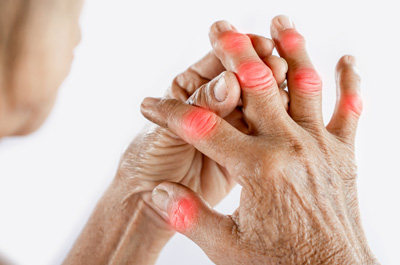 Studies have shown that about 30% of men and 3% of women in industrialized nations have elevated levels of uric acid in their blood. However, only about one in ten people with hyperuricemia actually develops gout. Overall, the prevalence is between one and two percent, making gout the most common form of arthritis in adults. In very rare cases, gout attacks also occur without a relevantly elevated uric acid level being detected. So while uric acid is a major factor when it comes to the risk of developing gout. Nevertheless, it is not the only decisive factor. We will take a closer look at other favorable or risk factors in a moment.
Although men are ten times more likely to have elevated uric acid levels than women, they are only about five times more likely to develop gout. The onset of the disease is typically after the age of 40. On average, women are even older at the onset of the disease, as they are largely protected from elevated uric acid levels until menopause thanks to estrogens. The female hormones support the kidney in its task of excreting excess uric acid.
It is interesting to note that gout often occurs in association with metabolic syndrome. This is a combination of various health problems associated with malnutrition and metabolic disorders: High blood pressure, obesity, diabetes, elevated blood lipid levels. For people suffering from metabolic syndrome, it is very interesting that with the help of vital mushrooms they can well stabilize their health condition and thus prevent gout disease.
In addition, the incidence of the disease increases with age. However, this is primarily due to other diseases and medications that involve elevated uric acid levels.
Studies have shown that about 30% of men and 3% of women in industrialized nations have elevated levels of uric acid in their blood. However, only about one in ten people with hyperuricemia actually develops gout. Overall, the prevalence is between one and two percent, making gout the most common form of arthritis in adults. In very rare cases, gout attacks also occur without a relevantly elevated uric acid level being detected. So while uric acid is a major factor when it comes to the risk of developing gout. Nevertheless, it is not the only decisive factor. We will take a closer look at other favorable or risk factors in a moment.
Although men are ten times more likely to have elevated uric acid levels than women, they are only about five times more likely to develop gout. The onset of the disease is typically after the age of 40. On average, women are even older at the onset of the disease, as they are largely protected from elevated uric acid levels until menopause thanks to estrogens. The female hormones support the kidney in its task of excreting excess uric acid.
It is interesting to note that gout often occurs in association with metabolic syndrome. This is a combination of various health problems associated with malnutrition and metabolic disorders: High blood pressure, obesity, diabetes, elevated blood lipid levels. For people suffering from metabolic syndrome, it is very interesting that with the help of vital mushrooms they can well stabilize their health condition and thus prevent gout disease.
In addition, the incidence of the disease increases with age. However, this is primarily due to other diseases and medications that involve elevated uric acid levels. How does gout develop?
In our body, uric acid is inevitably produced as a by-product when purines are broken down. Purines, on the other hand, are absorbed through our food. On the other hand, they are released during the degradation of cells. As the basic building block of nucleic acids, we absolutely need purines to store genetic information in the form of DNA and RNA. Now, if uric acid is formed during their breakdown, that in itself is not a problem. It even has an antioxidant effect, protecting us from free radical damage. However, we humans lack the so-called “uricase”. We would need these to turn uric acid into the more easily soluble allantoin. So, in the absence of this alternative, we must eliminate it as it is. About three quarters of the excess uric acid leaves our organism through the kidneys in the urine. The remaining quarter is excreted through the intestines, saliva and sweat.
What is the problem with uric acid?
So uric acid is a completely natural substance that our body has to deal with all the time. It only becomes a problem when its concentration rises above a healthy level. In many cases, the reason for this is insufficient excretion. Likewise, excessive production of uric acid may be to blame. That is why natural remedies for gout are usually designed to promote the excretion of uric acid or, as many vital mushrooms do, to down-regulate excessive production.
This is so important because above a certain concentration our body no longer manages to dissolve the uric acid. Consequently, it crystallizes and sodium urate is formed. These tiny, sharp-edged crystals are deposited preferentially in joints, bursae, tendons and also under the skin. These crystals then trigger the aforementioned inflammation with pain and swelling.
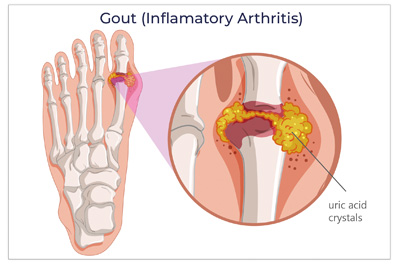
The body’s own complement system is involved in this process. This is a part of the innate immune system. It uses proteins to try to attract certain defense cells, such as neutrophil granulocytes, to the site of the incident. In this context, pro-inflammatory messenger substances (cytokines) such as tumor necrosis factor alpha and other pro-inflammatory substances are then released.
In this context, vital mushrooms with anti-inflammatory properties provide valuable assistance in alleviating the symptoms.
Primary vs. secondary gout
In medicine, a distinction is now made between primary and secondary gout with regard to the causes of gout. Primary gout is an inherited metabolic disorder in which the kidney’s excretory function for uric acid is impaired. Experts also speak of a so-called uric acid diathesis. In about one percent of those affected, overproduction of uric acid results from a genetically determined enzyme defect. In any case, primary gout results in an elevated uric acid concentration, which after a certain period of being symptom-free results in an acute gout attack.
If, on the other hand, there is talk of “secondary” gout, the focus is on a different problem that is causal for the disturbed uric acid balance. For example, gout often occurs as a concomitant disease of psoriasis or sarcoidosis (Boeck’s disease). Increased cell breakdown and cell remodeling in leukemia, hemolytic anemia, or during chemotherapeutic tumor treatment can lead to elevated uric acid levels. In addition, diseases that reduce the excretion of uric acid via the kidneys, e.g. kidney disease or type 2 diabetes, favor this form of gout. In addition, some medications, such as diuretics, ASA, and the Parkinson’s drug levodopa, promote the disease. Toxins such as lead, benzoic acid or mycotoxins can be just as causative. Finally, it is also known from fasting that the rapid breakdown of cells due to the lack of energy supply releases an excess of purines, which in turn affects uric acid levels.
Why does gout occur?
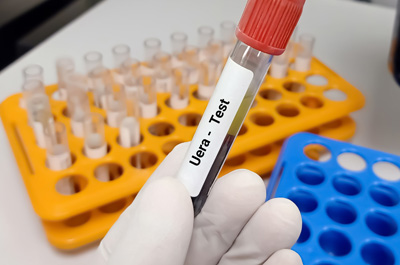 Where exactly is the critical uric acid level above which gout occurs? At up to 6.5 milligrams of uric acid per deciliter of blood, experts speak of a normal level. Anything above that is a risk factor for gout disease. Strictly speaking, this value applies to men, while the uric acid standard is set lower for women. However, when it comes to the risk of disease with regard to gout, the 6.5 mg / dl limit also applies to the female sex.
Where exactly is the critical uric acid level above which gout occurs? At up to 6.5 milligrams of uric acid per deciliter of blood, experts speak of a normal level. Anything above that is a risk factor for gout disease. Strictly speaking, this value applies to men, while the uric acid standard is set lower for women. However, when it comes to the risk of disease with regard to gout, the 6.5 mg / dl limit also applies to the female sex.
However, this does not mean that every person with elevated uric acid levels suffers from gout! Other factors, such as the environment in the joint and the temperature, also seem to play a role here. The lower (more acidic) the pH of the synovial fluid and the colder the tissue at the joint, the more likely the sodium urate crystals will form. However, above a concentration of 8 milligrams of uric acid per deciliter of blood, the probability of disease increases rapidly almost independently of the other two factors mentioned. It is therefore highly advisable to use natural remedies for gout as early as possible in order to prevent uric acid levels from rising so high in the first place.
Risk factors for a gout attack
- Alcohol consumption: Alcohol increases uric acid production in the liver and at the same time inhibits excretion via the kidneys. Therefore, the likelihood of a gout attack is significantly increased after an evening of heavy drinking. Due to the purine content, beer seems to be even more critical than wine in this context.
- Excess of purine-rich foods: Fish, seafood and meat are on average excessively rich in purines. Eating large amounts can therefore promote an attack of gout. In contrast, purine-rich plant foods do not appear to significantly increase the risk, according to studies.
- Drinks containing fructose: Drinks rich in fructose, such as cola, but also juices, are repeatedly associated with gout attacks.
- Uric acid-lowering medications: If drugs are administered that cause a sharp drop in uric acid, this can also promote gout. In fact, to compensate for the drop in the level, the body opens its uric acid depots. Inflammation can then occur at their edges. Here, natural remedies such as vital mushrooms are again at an advantage, as they never cause an excessive drop in uric acid levels.
- Age: The risk of gout increases with age, especially secondary gout.
- high BMI: With obesity and metabolic syndrome, all metabolic processes are impaired over time. That’s why uric acid can also overshoot more easily.
- Stress: Under stress or great anxiety, uric acid levels also rise. However, when the psychological stress subsides, it drops again. Here, for example, the medicinal mushrooms Reishi and Cordyceps can help well, as they reduce the stress experience.
- Surgeries: Increased uric acid levels could also be observed after surgery. The same is true for other severe physical stresses.
- Diabetes: Insulin and uric acid go hand in hand to a certain extent. For example, elevated insulin levels inhibit the excretion of uric acid. For this reason, diabetics relatively often have elevated uric acid levels. On the other hand, people with elevated uric acid levels are more likely to have insulin resistance than people with average levels.
Disease progression
Where does gout first appear?
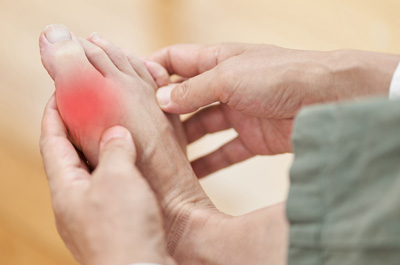 Typically, the first attack of gout in most people affects the metatarsophalangeal joint of the big toe. This is due to the fact that this is one of the coldest parts of the entire body and cold, as I said, promotes the precipitation of uric acid. The joint at the base of the big toe can be up to ten degrees Celsius colder than the rest of the body.
It is also typical that gout attacks start at night or in the early morning hours. Pain, swelling and redness then reach their peak after six to twelve hours. The affected joint is then extremely sensitive to pressure and hot. Accompanying fever and chills may occur.
It usually takes one to two weeks for the symptoms to completely resolve on their own. Because of the pain, an analgesic is often administered concomitantly. When the swelling subsides, the skin around the joint sometimes peels. In addition to the metatarsophalangeal joint of the big toe, the joints of the foot, knee, elbow, hand and fingers can also be affected by an attack of gout. Shoulders and hips, on the other hand, are very rarely affected.
It is diagnostically interesting that during a gout attack the uric acid level in the blood usually drops to a normal level!
Typically, the first attack of gout in most people affects the metatarsophalangeal joint of the big toe. This is due to the fact that this is one of the coldest parts of the entire body and cold, as I said, promotes the precipitation of uric acid. The joint at the base of the big toe can be up to ten degrees Celsius colder than the rest of the body.
It is also typical that gout attacks start at night or in the early morning hours. Pain, swelling and redness then reach their peak after six to twelve hours. The affected joint is then extremely sensitive to pressure and hot. Accompanying fever and chills may occur.
It usually takes one to two weeks for the symptoms to completely resolve on their own. Because of the pain, an analgesic is often administered concomitantly. When the swelling subsides, the skin around the joint sometimes peels. In addition to the metatarsophalangeal joint of the big toe, the joints of the foot, knee, elbow, hand and fingers can also be affected by an attack of gout. Shoulders and hips, on the other hand, are very rarely affected.
It is diagnostically interesting that during a gout attack the uric acid level in the blood usually drops to a normal level! What is the course of gout disease?
After an initial attack of gout, further attacks do not necessarily occur. Nevertheless, it is advisable to regulate the uric acid level, for example with the help of vital mushrooms. In addition, there are other natural remedies for gout, which we will discuss in a moment. If the affected person does nothing about the causes of the seizure and does not take any treatment, the next seizure usually occurs between six months and two years later. Follow-up attacks often affect other joints or even several at the same time. It also increases the average duration of seizures, making the pain longer to bear.
Finally, chronicity of gout is also possible. On average, however, this does not occur until twelve years after the first attack. Chronic gout is extremely distressing because it is associated with constant pain and inflammation in the joints. In addition, arthritic joint changes may occur due to cartilage and bone destruction. They increasingly restrict general mobility. A gout attack does not necessarily have to result in chronicity. Not even if it is left untreated. Researchers suspect that the change in uric acid levels over time plays a significant role here. Therefore, it is important for prevention to keep this in balance with the help of medicinal mushrooms and a balanced lifestyle.
Other health risks of gout
 As a further consequence of a permanently elevated uric acid level, so-called gout nodules or “tophi” can form. Approximately 30% of individuals with an untreated gout attack develop such nodules within five years. They are deposited near joints, on bones, cartilage and under the skin. This primarily affects the elbow, toe and finger joints as well as the Achilles tendons and the cartilage of the ear. The problem is that these gouty nodules cause permanent pain. The good news, on the other hand, is that treatment to lower uric acid, accompanied, for example, by vital mushrooms as a natural remedy for gout, also makes tophi smaller again.
As a further consequence of a permanently elevated uric acid level, so-called gout nodules or “tophi” can form. Approximately 30% of individuals with an untreated gout attack develop such nodules within five years. They are deposited near joints, on bones, cartilage and under the skin. This primarily affects the elbow, toe and finger joints as well as the Achilles tendons and the cartilage of the ear. The problem is that these gouty nodules cause permanent pain. The good news, on the other hand, is that treatment to lower uric acid, accompanied, for example, by vital mushrooms as a natural remedy for gout, also makes tophi smaller again.
Other consequences of gout depend on where else the crystals may be deposited. If they settle in the kidney or bladder, for example, the risk of kidney stones, renal insufficiency, kidney-related high blood pressure and urinary tract infections increases.
How to treat gout?
In the case of an acute attack of gout, the following measures have proven effective in practice:
- elevate the affected joint
- Cooling the joint
- consult a doctor about painkillers if necessary
Curing gout in the long term and preventing further attacks, on the other hand, requires more time. Finally, the entire metabolism must be brought back into balance. The key is to support the kidneys in their natural function as uric acid excretors. There are various approaches to this from naturopathy, which rely primarily on a healthy lifestyle and the support of vital mushrooms. In this context, we would first like to briefly discuss the aspect of nutrition before turning to the various medicinal mushrooms.
What foods are taboo for gout?
In connection with the formation of uric acid from purines, we have already briefly discussed the purine content of foods. Here, purine-rich foods of animal origin in particular have emerged as a risk factor for gout attacks. If your uric acid level is already elevated, they should especially avoid fish, seafood and, if possible, fatty meats. Furthermore, it is important to reduce the consumption of alcohol, especially beer, to a minimum. At the same time, you should always drink plenty of fluids so that the kidneys can work well. Still water is a good choice here and – if available – healing water rich in hydrogen carbonate, as this counteracts stone formations in the kidney. (Cold) herbal teas are also excellent thirst quenchers. Sweet drinks such as lemonade, cola or even fruit juices are not recommended.
Through diet, you not only have an influence on purine intake – you can equally influence the environment in your body. Since uric acid tends to crystallize in an acidic environment, you should prefer alkaline foods. These include first and foremost fruits and vegetables, but also nuts, herbs and, of course, mushrooms. Carbohydrates, on the other hand, should be reduced as much as possible, as they promote insulin secretion. A higher insulin level is always accompanied by a higher serum uric acid level. Also, for the sake of your blood sugar levels, eat only three meals a day. A high content of bitter substances additionally supports digestion and the elimination of waste products.
Other measures
 In addition to a balanced, plant-based diet, alkaline baths also help to raise the pH level in the body. This can be both full and foot baths. Also helpful for gout are regular sauna sessions. Please do sports only in the moderate performance range, because lactic acid is formed in the body during excessive exertion. In general, it is important to reduce stress and get enough sleep so that the body can generate well and the metabolism is not affected.
In addition to a balanced, plant-based diet, alkaline baths also help to raise the pH level in the body. This can be both full and foot baths. Also helpful for gout are regular sauna sessions. Please do sports only in the moderate performance range, because lactic acid is formed in the body during excessive exertion. In general, it is important to reduce stress and get enough sleep so that the body can generate well and the metabolism is not affected.
How do vital mushrooms help with gout?
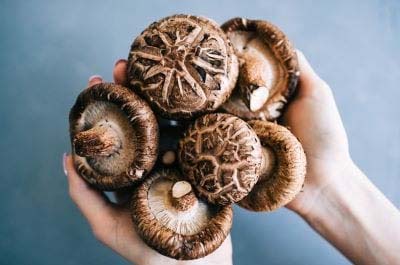
There is a selection of vital mushrooms that are particularly helpful for elevated uric acid levels and thus as a natural remedy for gout. In addition to Reishi and Cordyceps, these are Shiitake, Pleurotus and Maitake. However, other vital mushrooms can also be useful depending on the cause of the elevated uric acid levels, concomitant diseases and overall physical condition.
Our experts will be happy to advise you. You can determine the optimal combination and dosage of medicinal mushrooms for you individually.
Basically, the following properties of vital mushrooms are helpful in connection with a gout disease:
Improved renal excretion
Some medicinal mushrooms can have a lowering effect on the uric acid level in the blood thanks to their ingredients. For example, Polyporus and Poria cocos directly support the kidney in its work. Its diuretic and at the same time kidney-protective effect reduces the risk of suffering a gout attack.
Reduction of the risk of metabolic disease
Since both diabetes and metabolic syndrome are associated with elevated uric acid levels, it is important to address both problems before gout develops. Here, such vital mushrooms are helpful that protect and maintain the intestinal flora as well as those that regulate blood sugar and insulin levels. Very valuable medicinal mushrooms in this context are the Maitake and Coprinus.
Vital mushrooms containing chitin
Mushrooms such as the Maitake and Coprinus contain chitin. On the one hand, this is interesting for people who suffer from metabolic syndrome. In fact, it inhibits fat absorption via the intestinal mucosa. On the other hand, people affected by gout benefit from the chitin because the body breaks it down to glucosamine. This metabolic product is in turn a basic building material for cartilage. Thus it is essential for the health of tendons, bones, ligaments as well as joints. Especially older people often suffer from a lack of glucosamines!
Anti-inflammatory
At the latest, when joints are chronically inflamed, the anti-inflammatory properties of many vital mushrooms can provide relief. Of great importance in this context are the triterpenes and beta-glucans contained in the fungi, which directly influence the inflammatory cascade.
Antioxidant effect
Vital mushrooms contain enzymes, phenols and beta-glucans, which have an antioxidant effect in the body. In this way, they primarily intercept the consequences of (chronic) inflammation, in the course of which an excess of oxygen radicals is released.
Pain relief
Especially when the pain in the joints is unpleasant, but prolonged use of painkillers is unfavorable, medicinal mushrooms with antinociceptive effect can provide real relief. Mycotherapists like to use Reishi, Shiitake and Cordyceps for this purpose.
Which vital mushrooms help best with gout?
Vital mushroom Reishi
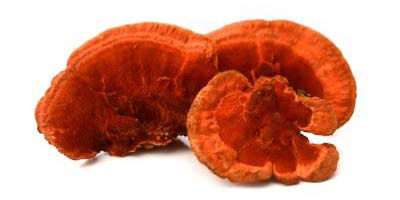 Reishi is a very important natural remedy for gout. It is not only analgesic, but also anti-inflammatory and antioxidant due to its high concentration of triterpenes. Thanks to its vegetative balancing properties, it promotes the regeneration processes in the body. At the same time, traditional Chinese medicine also attributes to it the ability to calm the mind. Lower stress levels reduce the risk of stress-induced increases in uric acid levels.
Reishi is a very important natural remedy for gout. It is not only analgesic, but also anti-inflammatory and antioxidant due to its high concentration of triterpenes. Thanks to its vegetative balancing properties, it promotes the regeneration processes in the body. At the same time, traditional Chinese medicine also attributes to it the ability to calm the mind. Lower stress levels reduce the risk of stress-induced increases in uric acid levels.
A central starting point of the Reishi is the liver. There it improves lipid metabolism, which prevents elevated blood lipid levels and consequently metabolic syndrome. Thanks to its prebiotic properties, the vital mushroom also improves the intestinal environment and positively influences the metabolism in this way.
Vital mushroom Cordyceps
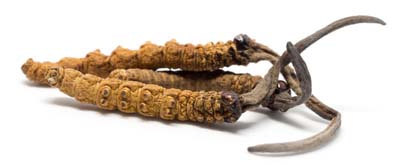 Cordyceps is the most important vital mushroom for the kidneys. It strengthens them in their function and protects them. It thus stimulates the excretion of urinary substances such as uric acid. Besides, it has a positive influence on the adrenal glands. Among other things, the stress hormones cortisol and adrenaline are released here. The regulative effect of cordyceps on hormone production makes itself felt stress-reducing.
Cordyceps is the most important vital mushroom for the kidneys. It strengthens them in their function and protects them. It thus stimulates the excretion of urinary substances such as uric acid. Besides, it has a positive influence on the adrenal glands. Among other things, the stress hormones cortisol and adrenaline are released here. The regulative effect of cordyceps on hormone production makes itself felt stress-reducing.
Finally, in connection with gout and the joint pain it causes, it should be mentioned that cordyceps has analgesic properties. It also buffers negative consequences of gout-related inflammation. In fact, the superoxide dismutase and glutathione contained in it develop their antioxidant properties in the body, which means that they render free radicals harmless. In addition, the ingredients of cordyceps regulate blood sugar levels.
Vital mushroom shiitake
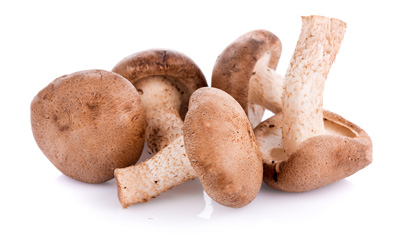 Shiitake is a vital mushroom that has been shown to lower uric acid. So it is an incredibly valuable natural remedy for gout – especially primary gout. Thanks to its alkaline properties, it provides an environment in the joints in which it is difficult for uric acid crystals to form. In addition, its ingredients rebuild damaged joints and promote their overall mobility. It is able to relieve possible pain in the area of the joints.
Shiitake is a vital mushroom that has been shown to lower uric acid. So it is an incredibly valuable natural remedy for gout – especially primary gout. Thanks to its alkaline properties, it provides an environment in the joints in which it is difficult for uric acid crystals to form. In addition, its ingredients rebuild damaged joints and promote their overall mobility. It is able to relieve possible pain in the area of the joints.
However, the shiitake is not only a pure vital mushroom, but also a valuable edible mushroom. Due to its high content of protein, it is considered an excellent substitute for meat. Unlike animal foods, however, it lowers cholesterol by driving the breakdown of cholesterol. This is a great help when someone wants to reduce their excess weight. In addition, it is very helpful that the shiitake exerts an alkaline effect on our body. In an acidic environment, uric acid crystals precipitate much faster than in a basic environment.
Vital mushroom Pleurotus
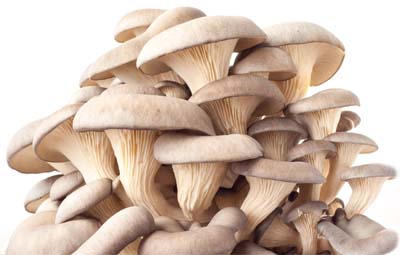 Pleurotus is also a tasty edible mushroom. It has a high content of protein as well as B vitamins. Especially people who are prone to metabolic syndrome should often replace a meat meal with a mushroom dish. Like shiitake, pleurotus has a lowering effect on blood lipid levels, reducing the risk of dyslipidemia.
Pleurotus is also a tasty edible mushroom. It has a high content of protein as well as B vitamins. Especially people who are prone to metabolic syndrome should often replace a meat meal with a mushroom dish. Like shiitake, pleurotus has a lowering effect on blood lipid levels, reducing the risk of dyslipidemia.
At this point it is also worth mentioning that its ingredients nourish and build the intestinal flora. All these properties are very valuable in the context of gout, because obesity and metabolic syndrome are clustered together with elevated uric acid levels.
With regard to the specific symptoms of gout disease, pleurotus can provide relief. In fact, it has a relaxing effect on muscles, tendons and joints – all the places where uric acid accumulates and gout nodules can form.
Vital mushroom Maitake
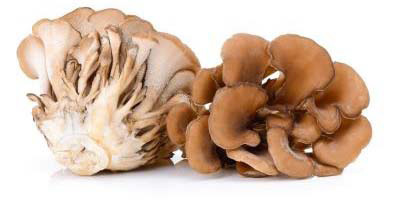 Maitake should be mentioned here primarily as a recommendation for people with problems with fat metabolism. In fact, it is the preferred vital mushroom when it comes to metabolic syndrome. As already mentioned, the risk of elevated uric acid levels increases as soon as the metabolism as a whole gets out of whack. Maitake helps here, for example, by boosting fat metabolism and subsequently lowering the level of triglycerides and cholesterol in the blood. Thus, it makes a valuable contribution to weight management. With regard to diabetes, it is also interesting that maitake can reverse an existing insulin resistance of the body’s cells to some extent.
Maitake should be mentioned here primarily as a recommendation for people with problems with fat metabolism. In fact, it is the preferred vital mushroom when it comes to metabolic syndrome. As already mentioned, the risk of elevated uric acid levels increases as soon as the metabolism as a whole gets out of whack. Maitake helps here, for example, by boosting fat metabolism and subsequently lowering the level of triglycerides and cholesterol in the blood. Thus, it makes a valuable contribution to weight management. With regard to diabetes, it is also interesting that maitake can reverse an existing insulin resistance of the body’s cells to some extent.

Every person is unique!
Our experienced team will be happy to advise you in detail and free of charge on all matters relating to your health.
Buy vital mushrooms against gout
Do you suffer from gout or are you aware of your elevated uric acid levels? Then vital mushrooms can help you alleviate both the causes and the symptoms. Before you start looking for a reputable grower of medicinal mushrooms, however, you should get good advice on which mushrooms will help best in your particular case.
Every person is different! Just as the causes of gout can vary, so do other life situations and possible concomitant diseases. Therefore, feel free to call our experts and tell them about your own situation. Thanks to many years of experience and in-depth knowledge, our experts can tell you the perfect vital mushrooms for you as well as create a detailed dosage plan.
When buying the medicinal mushrooms, you should then put the supplier through his paces. Central to this is compliance with German organic guidelines. Indeed, vital mushrooms must grow far from any pesticides, fertilizers and other chemical substances, because they immediately absorb and store them on contact. You then end up ingesting these toxins in addition to all the good ingredients and unknowingly harming your health. On the other hand, if the mushrooms are cultivated according to organic standards, you can be sure that there are no toxins in them. Furthermore, the manufacturer must guarantee a gentle drying process at below 40° Celsius. In fact, higher temperatures destroy valuable enzymes, which are then no longer available to your health. 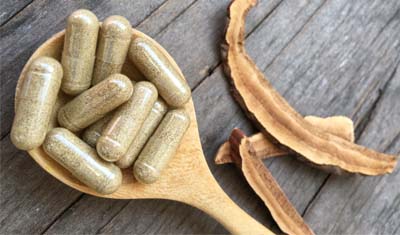 Finally, experience with mycotherapy has shown that powder in capsules is the ideal dosage form. It is essential that the whole mushroom is gently ground into powder in order to preserve all the ingredients. The capsule itself protects the powder from premature spoilage. Moreover, capsules are extremely user-friendly, as they are easy to dose and take.
Finally, experience with mycotherapy has shown that powder in capsules is the ideal dosage form. It is essential that the whole mushroom is gently ground into powder in order to preserve all the ingredients. The capsule itself protects the powder from premature spoilage. Moreover, capsules are extremely user-friendly, as they are easy to dose and take.
DO YOU HAVE ANY QUESTIONS?
We will gladly take time for you. In our free consultation we answer individually and personally all your health questions under:
